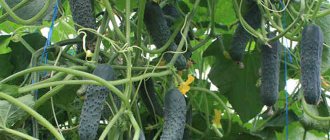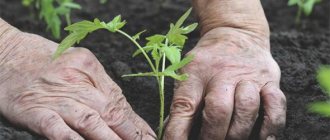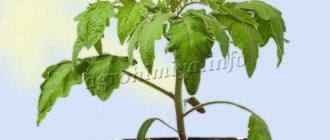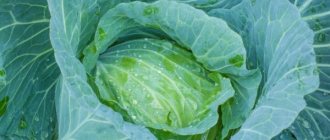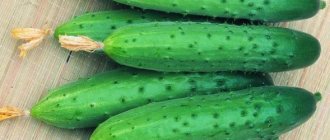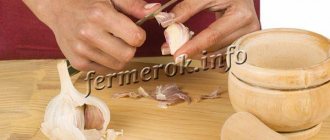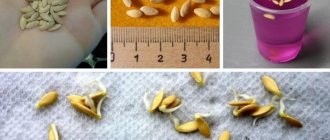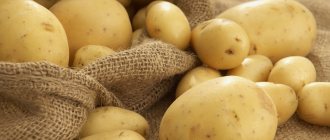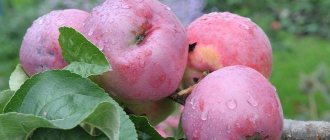Description
An early ripening variety of parsley, it is distinguished by its rapid growth of greenery, shade tolerance, and amazing aroma.
The leaves are large, dark green. High yield - 2.5-3.0 kg/sq.m. Both leaves and roots are suitable for use in cooking. Sowing can be done in spring - in April-May, in summer - at the end of July and before winter - in October-November.
Seeds are planted at a distance of 3-5 cm, the distance between rows is 25-30 cm; After this, they are mulched with peat and covered with a film, which should be removed when the seeds sprout.
It is necessary to make two thinnings, as well as feed the plant, weed it and water it in a timely manner.
Packaging: 2 grams
To buy universal parsley seeds “Bogatyr”, add the product to your cart and enter the data required for delivery of the product to your address.
Varieties of parsley
Everyone can choose an aromatic herb according to their taste, starting from the appearance and shape of the leaves and ending with the final purpose of use (tops or roots).
Among the popular varieties it is worth highlighting the following:
- Root parsley Piquant . It is grown for its fragrant root crops. Biennial. This variety is unique: even if you can’t get large roots, you can leave them in the ground for the winter, and in the spring the very first greenery will grow in such a bed. In addition, the plants subsequently form flower stalks and sow themselves. So, without any extra hassle, good root parsley will grow by the next season.
- Leaf parsley Italian giant . An annual plant, it has large leaves on long petioles, reminiscent of parsnips. Quickly increases leaf mass.
- Leaf parsley Gloria. Able to overwinter in open ground and regenerate itself. Early ripening variety.
- Parsley universal Bogatyr. As the name implies, the bush grows not only leaves, but also small root crops.
- Curly parsley Petra. It is distinguished by the original shape of the leaves - they are not simple, even, but corrugated, and at the same time they retain their appearance even after cutting. The variety is often used to decorate dishes.
Curly parsley looks very beautiful in flower beds as a border. Compact, low, lush and green bushes will advantageously shade a multi-colored flower bed until frost.
How and when to sow
And although it is possible to grow parsley using the seedling method, most gardeners refuse it because they do not want to make their life more difficult. Sowing parsley in open areas should be done at the end of April or in the fall. Leaf parsley can be sown using the conveyor method every 2 weeks. This will allow you to delight your loved ones with fresh herbs all summer long.
For cultivation, it is worth choosing a carefully lit area with light, loose, fertile and not very wet soil. It is best to use light loams and sandy loams, whose hydrogen values are 6.5 -7. You should not plant parsley in areas with high groundwater levels. If this problem occurs, then it is worth preparing high beds for parsley.
It will also be interesting to learn about how dill is grown on a windowsill.
The video shows how to plant parsley in open ground with seeds:
You can get a high yield of parsley if the following crops previously grew in the selected area:
Before planting parsley, it is necessary to prepare the site in the fall. First, add manure to the ground. Do this at the time of digging. There are 4-5 kg per 1 m2. If there is no manure, then mineral fertilizers can be used.
They need to be applied only in the spring and before planting. If parsley is planted for the winter, then it is worth applying fertilizers along with manure or compost.
Since dry planting material will germinate slowly, before planting it it is necessary to soak the seeds for 30 minutes in water. Then lay them out and dry them. Make grooves in the selected area, the depth of which is 1-1.5 cm. They should be at a distance of 1 m. When the seeds are sent into the grooves, sprinkle them with earth and water them.
But this video will help you understand how root parsley is grown from seeds.
It will also be interesting to know whether it is worth soaking tomato seeds before planting.
Maybe
Planting and care
Bogatyr parsley seeds are started to be sown after the soil has warmed to 4-6 degrees Celsius. Considering that it is not afraid of frost, it can be sown as early as the second half of April.
It is believed that parsley seeds, rich in essential oils, germinate poorly. For the Bogatyr variety, germination is up to 85% of the seed. Therefore, pre-sowing treatment does not play a big role. An exception is if the seeds are collected independently. They are recommended to be disinfected in a solution of potassium manganese.
- The site is first dug up and humus or compost is added. The optimal ratio is 3-4 kg per 1 square. But if the soil is poor, then more fertilizer can be added.
- Sand, peat, and rotted sawdust are used to loosen the soil. Parsley grows well in slightly acidic soils. Therefore, you should not use wood ash as a leavening agent, which increases the pH level.
- Seeds are sown in furrows 1.0-1.5 cm deep that have been previously generously spilled with water. Up to 3 rows are made in the garden bed with a distance between them of about 8-10 cm.
- Plantings are mulched with dry peat or soil. It is not necessary to water, so as not to wash out small seeds from the soil.
- The ridges can be covered with plastic film. In conditions of the greenhouse effect, seedlings will appear faster.
Interesting fact!
It is possible to grow Bogatyr parsley not only from seeds. If you dig up its root in the fall and transplant it into a container, then in winter there will always be fresh greens on the table. Albeit in small quantities.
Bogatyr parsley care is standard. Watering, 1-2 fertilizing with complex fertilizers, weeding and loosening the soil. Don't forget about thinning. 2-3 weeks after the emergence of seedlings, the crops are thinned out, leaving a distance of 5-7 cm between plants.
How to care
Even before the first shoots appear, caring for the crop involves careful watering, ventilation and weed removal. But when the sprouts appear, the plant will have to be weeded, loosened and fertilized from time to time. Parsley is thinned after 2-3 leaves have been formed.
Apply fertilizer 2 times before a leaf rosette forms. To do this, take 9 liters of water and send 15 g of potassium sulfide, superphosphate and 1 kg of organic matter. In August, stop feeding, which contains nitrogen-containing components. The fact is that they concentrate in the root system and above-ground parts.
Maybe
Pros and cons of growing through seedlings
Growing parsley from seedlings has many benefits. Thanks to this method of its cultivation, you can get an early, abundant harvest after planting in open ground.
The advantages include saving material for planting. This is especially important when using an expensive hybrid variety of parsley. Also, through seedlings, seed consumption is saved; in open ground, their consumption is much greater.
Heat-loving varieties, in cold regions, planted through seedlings take root better
At the same time, there are also disadvantages of this method. There is a need to create conditions. There are considerable costs associated with this.
Creating greenhouse conditions requires the purchase of materials for covering seedlings. The process is labor-intensive and time-consuming.
The best varieties for open ground
If you decide to grow parsley in an open area, then you need to choose only special varieties. Today there are quite a lot of them, but we will dwell in more detail only on those that are in great demand among gardeners.
Common leaf
This variety allows you to grow a plant that forms a large rosette with an abundance of leaves. They have a dark green color. The bush is also characterized by strong stems. The harvest can be harvested early and is always high.
Green crystal
This variety is a late ripening variety. It is universal and has an intensive growth of green mass. You can distinguish the variety from all others by such a feature as large leaves with an incredibly rich aroma. After cutting they grow very quickly.
Green crystal is a variety that is great for freezing. It retains its taste in dried, fresh form. Housewives also use it for preservation. It will also be interesting to learn about how to plant greens at home
Delicate aroma
This variety gives an early harvest. Its distinctive feature is the presence of shiny and bright green leaves. After cutting, the foliage grows rapidly and gives those around it an incredibly pleasant aroma.
And thanks to its excellent taste, parsley stimulates the appetite and is an integral decoration for both festive and everyday tables. For all greens lovers, it will be interesting to learn about how greens are grown hydroponically.
Morning freshness
This variety is early ripening. It has a large leaf rosette that is slightly spreading. The foliage is medium in size and dark green in color. And the parsley sprigs are very fragrant. After harvesting, new ingots grow very quickly.
Cut greens are left to dry for several days, unchanged in appearance. Morning freshness is actively used in cooking when preparing various dishes. And here you can read about how to grow eggplant seedlings without picking.
Festival
An early ripening variety that produces a harvest already on the 55th day after planting the seeds. It is distinguished by a highly developed rosette, on which there are 30-60 leaves. They have a dark green color, they are dissected, fragrant and grow back well after cutting.
Parsley sprigs have a pleasant aroma and taste, as they contain essential oils. To eat greens in their pure form, you need to cut off the foliage, the height of which is 10-12 cm. To dry, cut off the parsley while the buds are forming.
Bogatyr
This variety should be used by those gardeners who want to get a late harvest. Parsley can be cut 65 days after planting the seeds. Bogatyr can be used for growing in open ground or in a greenhouse. The rosette is large in size, its height reaches 25-40 cm. Up to 25 leaves are formed on it.
Their color is dark green. They are incredibly fragrant and grow back quickly after harvest. The rhizomes can overwinter in the ground and produce fresh greens in the spring. Parsley can be consumed fresh, dried or canned.
Sugar
This is an early variety that allows you to get a high yield of parsley. A bunch of green foliage is formed within 50 days from the formation of the first shoots. Root crops have the shape of a cone, the length of which is 20-22 cm.
Parsley Astra
The variety is early ripening. His young greens are formed 55-60 days after planting the seeds. Features a dense rosette. The foliage is curly, grooved and grows quickly after cutting. The variety allows you to get a high yield. It can be grown both in open and closed ground.
Parsley is a necessary component when preparing various dishes. It can be grown in open ground, since the crop is easy to care for and can even withstand winter well. If you follow the presented planting and care rules, then be sure that within 2 months your garden will be filled with lush, fragrant and tasty greens.
Description of the parsley variety Bogatyr
Parsley Bogatyr is a spicy crop with excellent characteristics. Thanks to its cold resistance, shade tolerance and early ripening to obtain aromatic greens, it can be grown throughout the Russian Federation.
In the photo and in the garden, parsley Bogatyr is a bushy plant about 40 cm high. The rosettes are semi-spreading, with long, fleshy petioles of light green color. The leaf blades are large, triangular, strongly dissected, consisting of three parts with dark green leaves with finely serrated edges.
In the middle zone, Bogatyr parsley most often acts as an annual crop. Umbrellas with small inflorescences of a greenish tint appear in late summer or early autumn. By this time, its tap root takes the form of a light gray root vegetable. Its length reaches 15-25 cm, and its weight is 95-100 grams. The resulting seeds are small, flat-round, brown in color.
Attention!
Most manufacturers and sellers of Bogatyr parsley seeds talk about it as a variety. But sometimes information slips through that the spicy culture is a hybrid. The last opinion is incorrect. Seed material retains its quality characteristics for several years and can be harvested by vegetable growers themselves.
Parsley Bogatyr has an excellent spicy taste and bright aroma. It is for the aroma and fresh appearance that persists for a long time after cutting that vegetable growers value this variety.
The Bogatyr variety is relatively unpretentious. To say that he does not need special care is not allowed by his tendency to certain diseases, which requires additional preventive treatments. And also parsley’s insistence on maintaining a watering schedule. Moisture deficiency leads to leaf stiffness and loss of taste. Its excess often causes the activation of spores of pathogenic fungi.
Description and characteristics of the plant
Parsley is a biennial plant from the Apiaceae family . Most often grown as an annual for its greenery and roots. In the second year of the growing season, the plant forms a peduncle with seeds. The culture reaches a height of 1.5 m. The curly variety is compact in size, the bushes grow up to 80 cm.
Leaf color ranges from bright green to dark green . The leaf blade is triangular in shape, twice pinnately dissected, matte below, glossy above. The leaves of curly parsley are strongly corrugated and slightly harsh.
The stems are erect, branched , thin or thick, depending on the variety.
Parsley root has a cylindrical, conical, spindle-shaped shape . The skin is gray-white, the flesh is white or creamy-gray. The length depends on the variety and is 18-30 cm. Weight is 30-300 g.
The greens of the root variety are dark green, smooth, and aromatic . The leaf blade is heavily dissected and slightly coarse compared to leaf parsley. The erect stem is highly branched and grows up to 1 m in height.
Peduncle with small yellow-green flowers collected in umbels . The seeds are oblong-ovate, brown-green in color. The culture enters the flowering period in July–August.
The taste of greens is refreshing, spicy, with an islandy aftertaste . The aroma is rich and tart. Parsley root has a strong aroma due to its essential oil content. The taste is reminiscent of celery and carrots at the same time.
Sowing of seeds is carried out in March - April after the soil has warmed up to a depth of at least 2 cm.
The seeds are subjected to stratification to increase germination: they are soaked in warm water for 2 days, then wrapped in a damp cloth and left until seedlings appear. Then the bundle is placed in the refrigerator for 10 days, then dried until it flows.
The plant is suitable for growing in open ground, a greenhouse, under film covers in greenhouses, and on a windowsill.
For cultivation on an industrial scale, Dutch cultivation technology is used in hydroponics - an artificial environment without soil. The root system is immersed in a nutrient aqueous solution saturated with oxygen or a porous substrate. This method involves frequent drip irrigation with nutrient solutions.
Mineral wool, expanded clay, sawdust, and coconut coir are used as a substrate.
Reference. In regions with a cold climate (in Siberia, the Urals), winter sowing of parsley and growing the root variety through seedlings are practiced. In the middle zone and in the south of the country, seeds are sown directly into prepared beds.
Parsley grows best in soil with neutral or slightly acidic acidity (pH=6.5-7.5). The crop needs sufficient watering, loosening the beds and weeding, thinning the crops and applying organic fertilizers.
The best varieties of leaf varieties
The table contains characteristics of popular varieties of leaf varieties .
Growing parsley at home
You can use fresh herbs for food not only in the warm season, but all year round if you plant curly parsley in an apartment, on a windowsill, on a balcony or loggia. In this case, sowing is carried out in February so that the emerging shoots become stronger during the lengthening daylight hours.
The seeds are pre-soaked and sown in soil consisting of two parts of garden soil and one part each of sand, peat and humus. Further cultivation of parsley at home practically coincides with agricultural techniques in open ground. Particular attention should be paid to watering, since in a limited volume the soil loses moisture faster.
You can make it easier to produce curly greens if you use annual parsley roots for forcing. How to plant parsley this way? In autumn, annual rhizomes are dug up and transplanted into deep pots with a 2-centimeter layer of drainage and loose nutrient soil mixture. Before planting parsley, the roots can be treated with a growth stimulant, which will activate their growth and speed up the appearance of greenery.
For growing on a windowsill, choose smooth, large roots with healthy apical buds, which, when backfilled, remain above the soil level.
Sometimes it is advised to plant parsley roots almost closely. This will produce a lot of foliage, but will quickly deplete both the rhizomes and the soil. Therefore, in this case, you cannot do without regular feeding. Curly parsley grown at home, if watered in time and occasionally fertilized, will produce a dense head of foliage within a month and a half, ready for cutting and consumption.
Secrets of growing parsley - video
general characteristics
"Bogatyr" is an early-ripening and high-yielding variety of parsley. From the moment of sowing until the first harvest of leaves, 55-60 days pass, and roots - 140-150.
From 30 to 100 leaves are formed on one branch of the plant; 3 kg of greens and 10 kg of root vegetables can be collected from a m2 of bed. The variety is resistant to flowering, low temperatures, diseases and pests. Suitable for repeated harvesting of greenery, since fresh leaves very quickly form at the site of the cuts.
Refers to biennial crops; the seeds remain viable for 2 years after collection. They have a high germination rate of 85-90%.
What is it and what does it look like in the photo?
“Bogatyr” grows a lush, semi-spreading rosette 20-40 cm high, consisting of thin, succulent stems and dissected foliage in the shape of elongated triangles. The above-ground part is shiny, painted in a rich dark emerald color, and has a pronounced spicy aroma. The edges of the leaf blades have rims of small teeth.
The underground part of the plant is a tap root 28-35 cm long. It has a cone-shaped shape and resembles carrot fruits. Parsley roots are painted white or gray-white, and their weight reaches 80-110 g.
“Bogatyr” blooms with single umbrella inflorescences consisting of small light green flowers. Closer to autumn, fruits appear - dry small seeds of a brown-green color.
Next you can see Bogatyr parsley, the description of which is given above in the photo.
Characteristics table
- Greens 3 kg;
- root vegetables 10 kg per m2.
- Wet rot;
- sclerotinia.
- Lungs;
- rich in humus.
Advantages and disadvantages
Benefits of Bogatyr parsley:
- the chemical composition is characterized by a high content of useful substances;
- good seed germination;
- bountiful harvest;
- short ripening period;
- the greens do not become coarse;
- resistance to drought and frost.
Disadvantages of culture:
- average resistance to diseases and pests;
- ability to reproduce by self-sowing.
Differences from other species
“Bogatyr” differs from other varieties of parsley in the following features:
- grows well in the shade;
- not afraid of sudden temperature changes;
- root crops do not sit firmly in the ground, so they are easy to pull out;
- able to reproduce by self-sowing;
- quickly increases green mass;
- Suitable for obtaining several harvests per season.
Diseases and pests
Parsley Bogatyr is resistant to diseases such as wet rot and sclerotinia. But it can be affected by fungal diseases such as gray rot and rust. When diseases appear, the affected plants are removed. Plantings are treated with a solution of Fitosporin, potassium manganese or Bordeaux mixture.
Among the pests that threaten parsley are aphids, carrot flies, and psyllids. Regular loosening of the soil, treating the plantings with a soap solution or infusion of onion peels and garlic feathers helps combat them.
A Brief History of Breeding
This leafy variety was developed in the late 19th century.
It received its name due to its high resistance to unfavorable climatic conditions of the growing area. The goal of the breeders was to obtain parsley with a rich chemical composition, good taste and presentation. By mixing several parent plants, they obtained and consolidated these characteristics, adding to them tolerance to drought and cold weather, as well as the ability to actively grow green mass in the shade.
Differences from other leaf varieties
This variety has the following differences:
- Shows high resistance to shady places, low and high temperatures.
- The root does not sit firmly in the soil, making it easily pulled out.
- Pronounced aroma with high extractive properties (increases appetite).
- Can reproduce by self-sowing.
- Quickly gains large leaf mass with natural thinning.
- Allows harvesting several times during the growth period.
- Suitable for forcing greenery during winter and early autumn.
Basic rules for growing outdoors
When is it planted in different regions?
Sowing parsley is carried out after the soil has completely thawed and the air has warmed up to 15 ° C. In different regions of the country, gardeners adhere to the following deadlines:
- southern regions - end of April;
- middle zone - early May;
- northern regions – second half of May.
Seeds planted in the soil can withstand frosts down to -5 °C.
Landing
The variety is photophilous, but can develop well in the shade, but the harvest in this case will not be very abundant. For planting, you should choose a place with fertile and light soil; it is dug up to a depth of 10 cm and fertilized with humus (3 kg/m2). A slight acidification of the soil is allowed. The predecessors of parsley can be:
- cruciferous;
- potato;
- onion;
- Solanaceae;
- turnip;
- garlic;
- eggplants.
Before placing in the ground, seeds are soaked for 1-2 days in warm water. 2-3 hours before sowing, it is recommended to dip them for 2 minutes in a weak solution of potassium permanganate or “Kornevin”.
The planting diagram can be seen in the following table.
Sowing technology:
- Prepare the bed and make furrows 2 cm deep at a distance of 15-20 cm from each other.
- Sowing, sprinkle the plantings with quicklime and soil.
- Moisten with a spray bottle or watering can with a diffuser attachment.
- Mulch with a layer of humus of 0.5-1 cm.
The first shoots will appear in 14-18 days. Until this point, all parsley care consists of regular watering and removing weeds from the garden. It is important to prevent overwatering and drying out of the soil, and also not to pull out green sprouts.
Care for the “Bogatyr” variety is carried out according to the following scheme:
- Thinning of plantings is carried out twice:
- After the formation of 2-3 true leaves, a distance of 3 cm is left between plants.
- 2 weeks after the first thinning, 5-10 cm are left between the grown bushes.
- Watering – parsley does not like dry or too wet soil. The procedure should be carried out as the soil dries; for this, warm, settled water is used.
- After each watering and rain, the soil is loosened between the rows. Weeds are removed as they appear.
- It is necessary to feed parsley 2-3 times per season. To do this, use purchased potash fertilizers (in accordance with the instructions) or sprinkle the soil with wood ash (250 g/m2).
To determine soil moisture, dig a hole 10 cm deep between the rows of parsley. Take a handful of soil from the bottom and try to form a lump out of it. If the soil is plastic, then there is enough moisture. But if it crumbles in your hands, then the bed needs to be watered thoroughly.
Harvest and storage
The full harvest takes place in late summer or early autumn, depending on the climate in the growing region. The greens are cut, cleared of soil, washed well and used for food. You can also place it in the freezer or dry it in a dark, dry place with good ventilation. In this case, parsley will retain its beneficial properties for 150 days.
Root vegetables are most often used for forcing greens in the cold season; they are rarely used for food. They are placed in fabric bags and stored at a temperature of 15-20 °C.
Growing parsley from seeds
- Soak parsley seeds for 1-3 days before sowing. Change the water twice a day. Then the seeds will sprout quickly and amicably. And a couple of hours before sowing, put them in a weak solution of potassium permanganate.
- Take a box (be sure to have drainage holes) and fill it with soil. You can use either soil prepared in advance at your summer cottage, or special soil purchased in a store.
- Water your home garden bed with hot water and tamp it down lightly.
- Make grooves according to the instructions on the seed packet. However, the distance between the grooves can be reduced.
- Sow the seeds shallowly, no more than 0.5 cm. The soil should be moist. In order to prevent the formation of a “crust” on the soil, sprinkle it with loose soil in a layer of about 1 cm.
To grow parsley from seeds on a windowsill, it is important to observe certain conditions :
- Do not allow the soil to dry out or become too wet . To do this, water moderately once a day: carefully, without eroding the soil. When seedlings appear, watering can be increased. Especially if there are batteries nearby and the air in the room is dry.
- It is important to maintain optimal thermal conditions . Ideally - from +15 to +20ºС. When the temperature drops, growth will slow down, and when the temperature rises, the parsley may begin to dry out.
- Maintain day length . To do this, you can place a fluorescent lamp above the box, about 60 cm from it.
- It is recommended to thin out young shoots if they are planted very often.
When the parsley has grown enough, it can be cut. It is believed that optimal “maturity” is branches 10-12 cm high. Disadvantages of this method: a lot of hassle. In addition, the first harvest will only be in 1.5 months. But such parsley will grow for longer than a year!
—
Is the method suitable for root and leaf varieties?
Varieties of leaf parsley are more suitable for growing seedlings. Root parsley varieties are more susceptible to damage during transplantation. Therefore, it is better to plant the latter before winter.
Root parsley with roots damaged during transplantation will produce root vegetables instead of a good harvest. In such varieties the root system is very vulnerable; any damage can affect the result.
The best root varieties of parsley include:
- “Alba” (ripens for a long time, up to 195 days, the root has a conical shape, elongated, up to 25 cm);
- “Harvest” (ripens up to 130 days, has a semi-spreading rosette, conical root up to 20 cm);
- “Final” (ripens up to 130 days, has a semi-raised rosette, narrow obverse-cone-shaped root up to 24 cm, petioles up to 29 cm);
- “Sugar” (ripens up to 105 days, has a powerful spreading rosette and a sharp conical root up to 20 cm).
Therefore, it is better to choose leaf varieties for seedlings. Although the roots can simply be carefully replanted. This is done by transshipment of seedlings while preserving the soil layer near the roots.
As for leaf parsley, the best varieties are considered to be Gloria, Breeze, Astra
Which varieties are better to choose?
For parsley seedlings, there are many different varieties available at gardening markets. Each of them produces a crop that has its own characteristics. But for growing parsley seedlings, it is better to choose high-yielding varieties. Those that give a rich harvest, have a high degree of growth after cutting and an unpretentious root system.
"Aster"
This variety produces curly-leaved parsley, early ripening. “Astra” matures in about 2 months and is distinguished by the fact that the leaf mass grows quickly after cutting.
Parsley curly aster
"Ordinary leaf"
Produces high-yielding, aromatic parsley. But it ripens late - about 70 days of ripening. But the variety produces spreading rosettes of 30-40 leaves.
"Breeze"
The distinctive features of this variety are that it produces large parsley and has excellent keeping quality. But it ripens even longer than the “Ordinary leaf” variety, up to 80 days of ripening.
"Esmeralda"
The variety produces a mid-season harvest of parsley with short petioles. This is one of the densest parsleys, produces rosettes of up to 30 leaves, and grows quickly after cutting.
"Bravo"
The parsley variety produces mid-season and high-yielding varieties. The height of the rosette of this parsley reaches up to 35 cm.
"Bogatyr"
It is characterized by high yield and shade tolerance. The variety ripens late (from 90 to 140 days) and grows well.
Leaf parsley hero
"Sandwich"
It has high cold resistance, produces semi-vertical rosettes and a large number of leaves. Ripening time is about 65 days.
"Curly"
A popular variety with a pleasant smell and taste. It has a dense rosette with a stem up to 1 m, the leaves are corrugated, the petioles ripen up to 70 days.
Curly parsley
